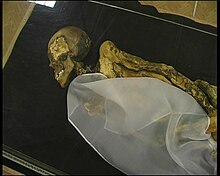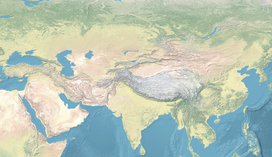Ukok Plateau
| Ukok Plateau | ||
|---|---|---|
| Укок / hohegh | ||
 View of the Ukok Plateau | ||
| Geography | ||
Location in the Altai Republic, Russia | ||
| Country | Federal subject Altai Republic | |
| Range coordinates | 49°18′28″N 87°35′41″E / 49.3078°N 87.5947°E | |

Ukok Plateau (
Terminology
The Mongolian word uheg literally means "elongated cabinet", "box", "massive mountain", or big hill with a flat top. According to the oral testimony of S. Umurzakova ukok in Kyrgyz used to refer to flat-topped mountains, i.e., plateaus. [citation needed]
Geography
The Ukok Plateau is the high-mountainous plain located between South-Altai and Sailugem and ridges at a height of 2,200–2,500 m (7,200–8,200 ft) above sea level. There are 500- to 600-metre-high (1,600–2,000 ft) mountain peaks that tower above the plateau. The highest peak on the plateau is the mountain knot of Tavan-Bogdo-Ula (Five Sacred Peaks) where the highest mountain is Khüiten Peak that reaches 4,374 m (14,350 ft) above sea level. This is the second highest peak in Siberia after Belukha Mountain.[3] The present-day eastern Altai-Sayan region areas of Ukok-Sailiugem could be considered the closest analogy to the ancient mammoth steppe environment.[4]
History


Transport

The Ukok plateau is linked to the outside world by heavy-going dirt roads through the Ukok (
Southward, beyond Kosh-Agach, the way becomes impassable for common means of transport and passable only for
See also
References
- ^ "Protect Snow Leopard Habitat / Siberia". forests.org. Archived from the original on 2007-09-27. Retrieved 2007-07-31.
- ^ "Altai: Saving the Pearl of Siberia". Archived from the original on 2007-03-22. Retrieved 2006-11-30.
- ^ "Ukok Plateau".
- PMID 24454791.
- ISBN 0-8160-4051-6.
- ^ "Golden Mountains of Altai". UNESCO. Retrieved 2007-07-31.
- ^ "Ice Mummies: Siberian Ice Maiden". PBS - NOVA. Retrieved 2007-07-31.
- ^ "Prehistoric Art - Early Nomads of the Altaic Region". The Hermitage Museum. Archived from the original on 2007-06-22. Retrieved 2007-07-31.
- S2CID 162580662.
- ^ Leigh Fenly (December 8, 2004). "Archaeology News". Archived from the original on August 2, 2009. Retrieved 2007-11-27.
- ^ "Minor nationality of Russia demands the return of "Princess of Ukok"". Pravda. February 21, 2005. Retrieved 2007-11-27.
Further reading
- S.I. Rudenko, Kul'tura naseleniia Gornogo Altaia v skifskoe vremia ("The Population of the High Altai in Scythian Times")(Moscow and Leningrad, 1953) translated as Frozen Tombs of Siberia: The Pazyryk Burials of Iron Age Horsemen, M.W. Thompson, tr. (University of California Press, Berkeley) 1970. ISBN 0-520-01395-6


